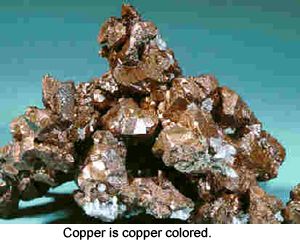BACKGROUND:
A mineral is defined as an inorganic solid material with specific
physical and chemical properties and a stable internal structure. Minerals
maybe composed of one or more elements or compounds. Minerals have to be
naturally created or else they are classified as man-made substances.
Rocks are combinations of minerals. Minerals are important for several
reasons. Some groups of minerals indicate the temperatures and pressures at
which they were created, and can be used to interpret the history of the
rocks. Minerals are economically important as gems, metals, abrasives,
fertilizers, and many other commodities. Historically, minerals have played
an important part in the settling of the western United States as well as
other nations. Finally, minerals are one of the building blocks of the bones
in our bodies.
PROCEDURE:
-
Review minerals with the students. Explain that
minerals have different shapes and colors. Some minerals grow into
pretty crystals, while others do not. All mineral crystals have definite
shapes.
Give each student or each student group a set of the
following minerals:
GRAY - HEMATITE
GREEN - ADVENTURINE (a type of quartz)
WHITE - DOLOMITECLEAR - QUARTZ - crystal
COPPER - COPPER
PINK - ROSE QUARTZ
GOLD - PYRITE - crystal
-
 Review the colors with the children. Ask them to
repeat the words several times and find the crayons that are the
appropriate color for each of the words. If the children have many
crayons, they will notice that there are many different shades of a
particular color. In nature, many of the colors they see are not pure
colors.
Review the colors with the children. Ask them to
repeat the words several times and find the crayons that are the
appropriate color for each of the words. If the children have many
crayons, they will notice that there are many different shades of a
particular color. In nature, many of the colors they see are not pure
colors.
-
Allow the students time to trace the word with the
correct color (with the word "clear" have children outline the
word). The students are then to find the minerals that best fit the
indicated colors. Students may have trouble determining the exact colors
of the minerals. Usually if a student picks a different color than you
did, he or she had a good reason. A child's eye sometimes picks up
shades adults don't see! You may want them write the name again in the
appropriate color.
-
Ask the students to put the mineral next to the
correct color. Monitor their work by moving about the classroom.
-
After the students examine each of the specimens you
can discuss with them if any of the minerals were crystals. Hopefully,
they can distinguish quartz and pyrite as crystals. Some of the samples
are broken pieces and therefore their crystalline structure may be
difficult to see.